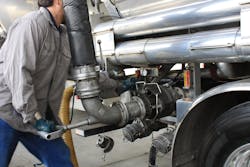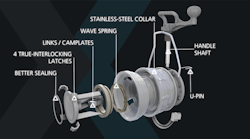Without doubt, the piece of equipment that is the true workhorse in any type of liquid-storage terminal is the bottom-loading API coupler that serves as the conduit between the loading arm and the tank truck. In high-volume terminals, it is not unusual for these couplers to be connected and disconnected more than 50 times a day. That is 50-plus head-on collisions between the coupler and adaptor, which translate into a huge amount of use and abuse.
Over the years, the design and operation of API couplers (also known as “load heads”) has evolved to the point that they can reliably withstand the abuse they are subjected to on a daily basis. However, the most dependable terminal liquid-transfer operations are the ones in which the terminal makes every effort to ensure the couplers and their components are cared for to the extent that the operation will consistently run smoothly. Terminals that experience excessive interruptions in their liquid-transfer service are ones that can’t meet the demanding delivery schedules of their customers, with the result being lost revenue for both and—maybe even more damaging—a loss of reputation.
6 critical loading-rack concerns
With that in mind, there are six areas of concern that terminal operators must be on the lookout for and remedy if the efficiency of their couplers, and their overall loading-rack operations, are to meet expected operational standards:
Seal wear: If a coupler is experiencing leaks after it is connected to the delivery vehicle, the most likely culprit is a worn seal. Specifically, the nose seal, which is the primary link between the truck and the coupler, may need to be replaced. Terminal operators must monitor this seal constantly and replace it at any sign of wear, lest a leak point develop.
Loading arm adjustment: Another potential cause of leaks could be the positioning of the loading arms. Ideally, the loading arms should be balanced at the truck adaptor’s height of 30 to 35 inches off grade. If the arms are positioned either lower or higher than recommended, undue stress on the loading system can result, which can lead to the creation of leak paths.
Weak or broken wave springs: While the first two conditions will generally result in minor leaks, a weak or broken wave spring in the coupler can lead to a significant product loss. The wave spring is critical in producing effective coupler operation because it creates seal compression when it is connected to the truck adaptor. Closely monitoring the performance of the wave spring is important because if it were to break, resulting in insufficient seal compression, the coupler will need to be taken out of service. And while it is replaced, that downtime will compromise fuel-delivery schedules.
Thermal expansion: Most couplers are rated for use at 75 to 80 psi (5.2 to 5.5 bar), but they can experience much higher pressures if thermal reliefs are not in place and functioning properly. In fact, extreme thermal expansion can create pressures in excess of 300 to 500 psi (20.7 to 34.5 bar). At pressures this high, the coupler could be at risk of a catastrophic failure leading to extreme loss of product. If the technician is having difficulty opening or closing the coupler handle, this may be a sign of thermal-expansion issues.
Extreme temperatures: Regardless of the ambient temperature, the terminal must keep product flowing. This can become more difficult to do when extreme temperatures are experienced. This is especially true when extreme cold takes hold. Most couplers are designed to operate effectively at temperatures as low as 0ºF (-18ºC), but the seals may become compromised—leading to product leaks—if the temperature gets much lower. In this case, the terminal operator should consider employing one of the new cold-weather couplers that can operate in temperatures as low as -40ºF (-40ºC) that have begun to enter the market.
Dirt and debris buildup: Terminal operators should regularly check the latches and cams on their couplers for any buildup of dirt and debris. If any contaminants are allowed to collect in the coupler, the cams may catch and create an imperfect seal, which can result in leaks. Extra attention should be paid to this area in the winter months when road salt and sand can collect on the face of couplers.
To the rescue
Knowing how important it is for terminal operators to optimize their loading-rack efficiency, the manufacturers of bottom-loading API couplers have worked on developing advanced technologies that can meet the demands of high-volume liquid-transfer activities around the world. One example is the Lynx Bottom-Loading Coupler from OPW Engineered Systems. This advanced coupler model combines all of the best features of API couplers in one device that has been designed to provide a superior and effortless bottom-loading experience.
The fulcrum of advanced API coupler design is the use of a unique U-pin that allows assembly and disassembly of the coupler in no more than 30 seconds. Other key features of the advanced design include:
- In-field replacement of the main seals, on or off the arm
- Wave-spring design that will last three times longer than competitive models
- Durable stainless-steel collar and hard anodized aluminum body for increased service durability and life
- Four “true interlocking” stainless-steel latches that ensure secure coupling and maximum product containment
- A wide variety of seal materials, including fluorocarbon, Buna-N (nitrile) and FFKM
- Short 5.9” (110 mm) and long 7.8” (200 mm) operating-handle lengths
- Ergonomic operating handle and carry loop puts less physical strain on users
- Maximum working pressure of 80 psi (5.5 bar)
- Maximum surge pressure of 493 psi (34 bar)
- Common operating temperatures from -40ºF to 176ºF (-40ºC to 80ºC), with low-temperature seal options available
All of these features—and how they optimize the efficiency and reliability of these models of advanced API couplers—can enable manufacturers to offer, for example, a five-year warranty on their operation.
Conclusion
The millions of gallons of fuel that pass through a storage terminal every year would have nowhere to go without API couplers. That means their design and reliability must be unquestioned if the terminal is to feature a truly efficient loading-rack operation. Next-generation API couplers that can overcome the six concerns that can lead to compromised coupler operation and, by extension, loading-rack efficiency can be recognized as true—and reliable—terminal workhorses.


